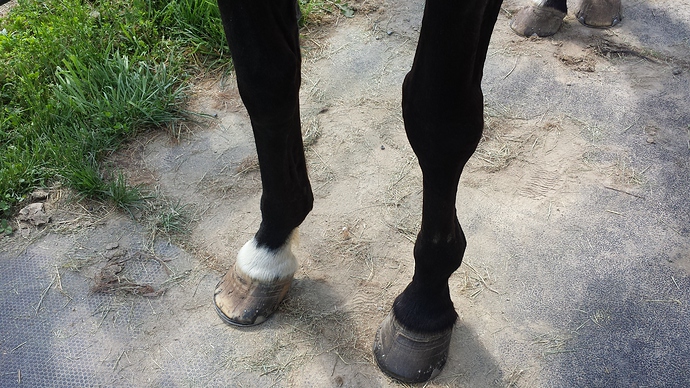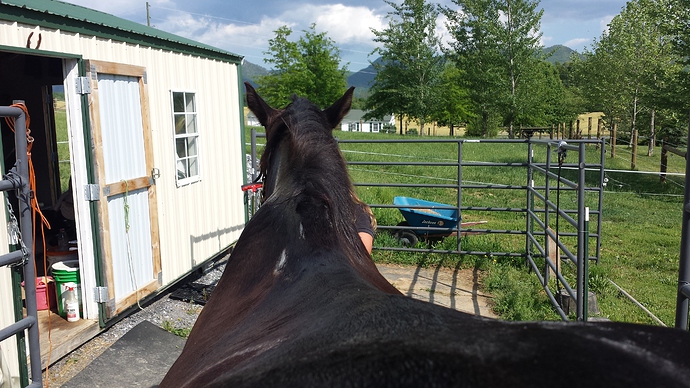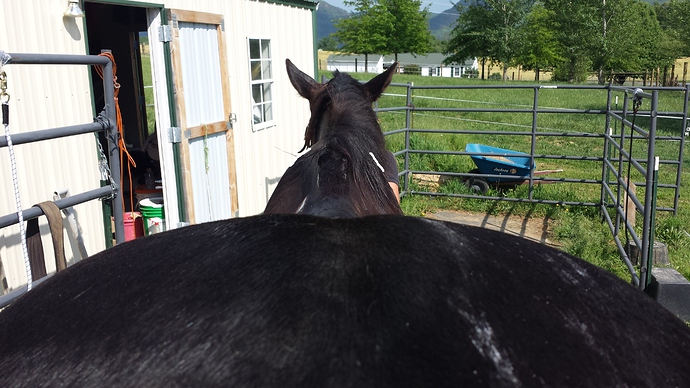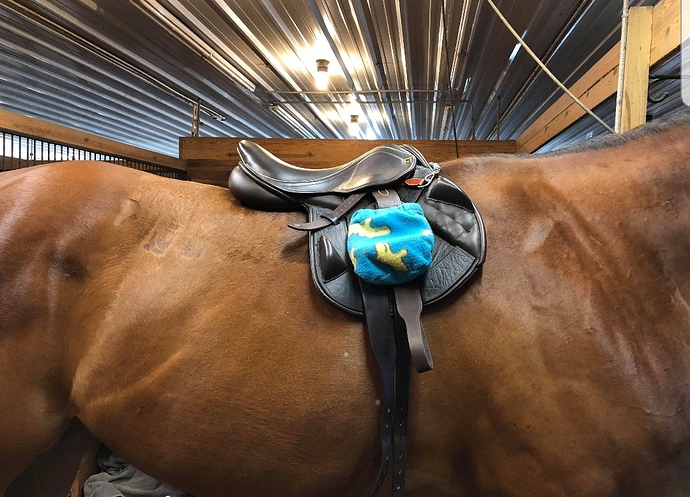I will not buy a saddle that I cannot try on my horse before paying for it. I know far too many people who loved the demo and hated the saddle that arrived for them. These days, there are so many configurations of saddles available that you can almost always find the configuration you want on the used market. Because these are not “custom” saddles, these are saddles assembled from parts to specifications.
There are lots of reasons why a grown horse’s back can change. Yes for most horses once they are fully grown, their saddles should reasonably fit them well for years.
However there are lots of reason why their body/back changes shape once they are fully grown. Reasons may include change of location, diet, injury, farrier work, and change of program or how they are ridden.
My experience has been that the horse can lose or gain weight, but unless they start getting lordosis in extreme old age, the basic shape of the back is the same. If they lose fat on the withers and the saddle appears too wide a sheepskin pad will fill everything in. If they start to bulk up you can remove wool flocking or it can even compress a bit and mold to the horse. IME the saddle that actually stops fitting may not have been the best fit to begin with.
I disagree. In the average horse yes. I would say about 20% of the grown horse I see, need a different saddle after a year or 2. Mostly due to injury or a big change in work load or change in environment.
I am working with a horse now that needs a different saddle than the one she got 2 years ago. The horse went from 3rd/4th and now trying finish out at Grand Prix dressage. The mare’s body has changed with the increased work load.
Any horse that has a major injury, their body changes with stall rest. I have seen horse’s back dropped due to lack of conditioning. I have also seen horse’s back get flatter. Basically they were guarding from pain and hunching their back. So as the pain goes away, they relax and their back’s get flatter.
I have also seen major changes with different farrier work for good and bad that affect’s the entire body.
As a fitter I see hundreds of horses a year.
But the things that don’t change – the curvature and shape of their spine and general shoulder shape – are the basis of what make a tree fit or not. If a horse is changing shape to the point they need a new saddle every few years, that tree never fit them on a genuine level. Wool flocking addresses things like more muscle or fat over their back.
The shoulder aka scapula definitely changes. It is attached by soft tissue and nothing is holding it the same place. The posture of the horse changes the shape of how the back holds a saddle. When I have a few mins on my computer, I will pull out some pictures.
I would love to learn more about that, so thank you.
I have some extreme examples I can show. I normally forget to take pictures, but these were so bad, I remember to take them.
These are examples of how the hoof can effect the saddle.
I don’t have pictures available for this example. A midteen horse with a club front hoof. At the knees, one was about an inch higher than the other. At the point of the shoulder, it was about 2 inches. His scapula were very uneven and it continued to his spine. If you looked at it from behind it was crooked.
The pictures are of a Foxhunter going first flight. The xrays of his foot’s structure apparently was normal according to the vet. In the picture from the rear, he is standing square. It is also hard to see, but his right scapula was about 4 to 6 inches ahead of his left. Yes inches. All the saddles sat completely crooked on him. Unfortunately before we got the saddle sorted, he had a pasture accident and passed away.
How do I attached pictures? I know I have before but can not figure it out again.
This is a younger TB around the age of 7 at this time. It has been a few years, so the timing maybe off a little. I has been working as his saddle fitter from the age of 4. One appointment, I had seen him and told the owner that we may need to widen the saddle as he finished growing because it was getting a little narrow. Fast forward from about 4 to 5 months, all of a sudden the saddle was pommel low and too wide. At this point, I recommended a vet consult to see what was going on. They took xrays and diagnosed him with kissing spines and he was clearly not comfortable under saddle. The following pictures were taken within a couple of days of each other.
Unfortunately the before picture was not taken by the client. Before was the saddle sitting way too low in front before they injected his back. One picture is the day of the injections (blue stirrup cover) and the other a few days later. The most interesting comparison is the horse’s posture. The lumber area is a completely different shape. He was in so much pain, his entire posture and body shape changed after the injections.
As with sheltona01, I find it is not at all unusual for a horse to need a new saddle as it develops in its training. And I don’t take enough pictures! But here is a blog post I wrote on the topic, with tracings: [https://thesaddletree.com/2021/05/28/playing-the-long-game/]
At the bottom there is a link to another post in which I show pictures of my own horse whose back has certainly gotten flatter over the past year. I’m working on getting him a jump saddle soon and was just noticing that some saddles that I tried on him last year and ruled out as being not curvy enough are real possibilities this year.
Wow. Those feet are genuinely awful. In that horse’s case, how was he sound? I understand feet can affect posture and eventually, muscling and/or topline loss… But then when the horse is “back to normal”, should they not once again need their former saddle? In those extreme cases I really question whether they are even sound enough to be ridden ethically.
Regarding the KS horse… I admit without the full body pictures showing the postural changes its hard for me to see a huge change. I do see in the last picture the saddle appears to be sitting higher, but it’s also taken from a different side and angle than the first.
I’d be interested to see the feet in the KS horse.
Having gone through that craptastic journey myself, the biggest change in comfort for my horse with KS wasn’t things like back injections or therapies. It was fixing his feet.
I am still not personally convinced a sound horse needs a new saddle every few years. Obviously the pictures show extremes that had a lameness component external from the saddle fit. Horses should not suddenly lose topline or drastically change shape in their adult life. If they do something is wrong.
@beowulf you would probably have to follow a full time saddle fitter around for 3 years or so to get the info that would convince you. And even then, there would be no rewinding to review the original decision on a horse’s body from years before to see if an error was actually made. So maybe give a little more credit to those of us who eat, sleep, and breathe saddle fit. 
In the case of the horses in the blog post that I linked to, the saddle I put them in actually did NOT fit initially and that is the only reason it was able to fit months or years later. There was room for the horse to grow into it. I’ve actually been yelled at by other fitters for doing that - I’ve been told there is no way to predict how a horse will change. My background of being a trainer for many years provides the insight to be able to make pretty accurate predictions in some cases. Had I fitted the saddle to those horses as they were on the day I initially saw them there is no way their saddle would have fit later on, and that is what most fitters do. In fact, that is what they are being paid to do.
My own horse was a weird enough shape that I did not feel able to predict what the end result would be so I fit him as he was, repeatedly, (saddle after saddle after saddle after saddle…) until he stabilized. He’s had his big-boy saddle for about 8 months now and it’s fabulous but I don’t expect it to be his last saddle because I expect his level of training to change a great deal.
Both of us fitters did say that it is a small minority of horses that require a new saddle after only a few years, but some circumstances that can have a big impact include:
- moving to a new barn
- new feeding program
- new body worker
- training progress
- change in feet
- getting a new saddle
An adult horse who has been in a consistent program long enough to stabilize before getting a saddle, and who remains in that program afterward, would certainly be expected to remain in the same saddle until his back starts to drop from old age. Most horses don’t have that stability. In spite of that instability, most horses can stay in the same saddle for years. But some can’t.
Finally, please realize that your standards for an adequately fitted saddle are probably significantly different from those of @sheltona01 and I. We are only satisfied with perfection. Someone upthread said something like “a sheepskin pad will fix everything” if a horse loses weight. Umm no. Definitely no. Not if you want the best performance from your horse.
I thought about ending with a wish that your saddle would continue to be an optimum fit for a long time to come, but personally I’d rather have such tremendous success with training my horse that his body is transformed enough to need a new saddle. Doesn’t that sound like more fun?
You can give me a little credit too - I have more than twice that amount of years of dealing with saddle “fitters” who have no idea what they’re doing and watching them systematically and effectively decrease the performance of their clients’ horses. 
I do recognize my standards for saddle fit are very different than those of fitters. I’ve had the unlucky experience of having more bad fitters than good. I’ve had fitters tell me uneven panels are okay, and I’ve had fitters tell me bridging is ideal. I had a fitter tell me that the lack of wither clearance in a custom saddle of a client of mine was okay because they ride in Mattes pads. I’ve had fitters say that my horse’s decrease in performance was rider caused, girth caused, farrier caused, weather caused – all the while they never considered that the tool that they put on my horse’s back might be the source of the horse’s problems.
And I’ve gone through this more than once, with more than one saddle fitter. I’ve taken two of my competition horses to top lameness vets in the country because of their performance loss, about ten years apart – and when I got to the riding phase both of them said “stop, it’s the saddle - you can get off now”. In the first horse’s case, that saddle had been seen regularly by a very well known fitter here for the last three years… In the second horse’s case, the saddle was custom made to him.
So you’ll have to forgive me for my general reluctance to assume any person calling themselves a saddle fitter is competent until they show me otherwise.
Now – don’t get me wrong. The average owner can’t tell that a horse has terrible hoof angles, is bilaterally lame, or is telling them something is NQR. I know this, and you probably couldn’t pay me enough to become a (certified) saddle fitter for that reason. I imagine it’s a Sisphyean task trying to make a saddle comfortable for a horse who hurts everywhere… Sometimes the first thing the clients, the trainers, and the instructor points to is the tool on the horse’s back – without ever looking at things like diet, management, or hoof care first.
However, there are saddle fitters out there who aren’t doing the horse any favors, either. Don’t discount the experiences of your clientele – especially when a saddle fitter has a bevy of unsound and unhappy customers in their wake.
@sheltona01 I know and respect - they’ve been on this forum a long time and we have had many conversations about fit, horses, and general care over the years. I don’t believe I ever questioned their knowledge or competency. I always enjoy their posts because I get a glimpse of their experiences and learn a little from it, too.
We were discussing the average horse – which sheltona01 agreed, the average horse shouldn’t need a new saddle every few years. In your scenarios, you are talking about horses outside of the average: unsound and/or sound-again horses with physical problems that altered the shape of their back. You’ve taken what I’ve said and applied it to extremes; yes, lordosis and swaybacks are extremes and often unpreventable. Yes, bad feet causing topline loss are extremes. Yes, an injury can cause uneven muscling. But most of these things require time off so they shouldn’t be ridden – and in the event they are ridden, they can be addressed by reflocking and/or saddle adjustments.
The best thing I ever did for my horses was trust but verify the competency of the people in his circle. From his farrier, to his vet, to his saddle fitter and chiropractor. I used to just assume the professionals in his ring were exactly that, and knew what they were doing. That assumption cost a lot of money and pain on my horse’s behalf: from tolerating bad farriery to tolerating bad saddle fit. I spent a lot of money and time undoing the physical complaints caused by their failures, and there’s many stories like mine on COTH and word of mouth.
You are missing the point that while you have years of experience looking at horse’s backs you do not have the volume of experience, looking at the numbers of different backs that we look at on a daily basis. And you are deliberately obfuscating the point that shelton0a1 and I both stated that we do see such changes in “normal” backs, we simply don’t have pictures of them, or the pictures are subtle enough that the differences are hard to see. The two horses mentioned in my linked blog post were normal backs in the eyes of their owners, as well as the horses’ vets. Yet they changed dramatically.
It seems however that the point you now want to argue is that some fitters don’t know what they are doing and when they do a poor job they blame it on the horse for changing. I will not argue that point. However if the horse goes comfortably in a saddle for two years and then suddenly doesn’t anymore, it probably wasn’t the saddle that changed!
I generally try to stay above bickering on COTH, but:
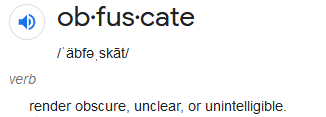
Ex 1: I said: " An adult horse’s back does not change that much that a custom saddle that fit them when they were 8 would suddenly not fit them at 10"
Ex 2: Sheltona01 said:
“Yes for most horses once they are fully grown, their saddles should reasonably fit them well for years.”
" In the average horse yes. I would say about 20% of the grown horse I see, need a different saddle after a year or 2. Mostly due to injury or a big change in work load or change in environment."
Ex 3: I said: “I am still not personally convinced a sound horse needs a new saddle every few years. Obviously the pictures show extremes that had a lameness component external from the saddle fit. Horses should not suddenly lose topline or drastically change shape in their adult life. If they do something is wrong.”
What I am reading is that Sheltona01 and you agree – that in a sound horse their bodies should not change so drastically that they need a different tree under most normal circumstances. However, you are saying I am wrong, and providing me examples of unsound horses or horses with extreme pathological issues and justifying why they need a saddle change.
That is not pari passu.
I don’t know how else to explain that to you.
Absolutely. And when you continue to cherry pick from the conversation, ignoring the parts you say aren’t present, you can continue to draw the same conclusions. Thanks for supporting my statement regarding your obfuscation.
 I generally believe in street epistemology – in short, challenging my own held beliefs (and the reasons I hold them) especially when outside perspectives challenge mine. I’m going to ignore the snark and multiple jabs you’ve made at me in general trying to discredit my experience, and try to focus on some of the things you’ve said for the sake of civil discourse:
I generally believe in street epistemology – in short, challenging my own held beliefs (and the reasons I hold them) especially when outside perspectives challenge mine. I’m going to ignore the snark and multiple jabs you’ve made at me in general trying to discredit my experience, and try to focus on some of the things you’ve said for the sake of civil discourse:
You’ve linked to your personal blog about two horses and called them “normal”. One has lordosis and was a starvation case. In no rational circle is a horse with lordosis considered a normal or healthy back.
The other is just wither and body tracings. We have no info on this horse. Was he young? Was he a fully mature horse? To the outside observer your traces look like what is fairly typical as a young horse matures and I wouldn’t call that groundbreaking at all… but I see a lot of young horses grow into mature horses. 
When I asked for more information about these normal horses needing new saddles, you just gave me a vague answer to follow around a fitter for three years, and cheekily questioned my life experience on saddle fit. And then you say I am “cherry picking” because I am going off of the only examples you provided.
I think you are missing the point that these are not sound, average horses you are pulling from your data pool to provide your questioning audience. Lordosis, feet imbalance, and kissing spine are not sound, normal horses.
You say you’ve had normal horses change, but you’ve failed to objectively define you version of normal other than to lump a lordosis horse into “normal” category. You say there are all these reasons a horse might change over their back – management changes, farrier changes, training progresses, etc (which I agree with) – but again, I ask you to seriously consider whether these horses were sound if their management and shoeing were so severe that it negatively compromised their body condition.
And if they were actually sound, why was their body so compromised?
The key word here is sound. I’ve said from the beginning, we are discussing sound horses. Maybe your definition of sound is different than mine.
If saddle fitters(g) are properly fitting saddles based on tree configuration and compatibility with the horse’s conformation, are they not considering the horse’s basic anatomy? That is their skeleton; this does not typically change throughout their lifetime once they are mature barring trauma or compensation from trauma. Any tissue minutiae changes – fat pads, muscle – can be addressed by reflocking the saddle provided the panel and tree shape always fit the horse in the first place. These tissue changes are not going over the shoulder, the withers, and the spine of the horse. Even as fat as a horse can get, the fat pads typically fill in last on areas where it would negatively compromise saddle balance like the top of the ribcage and behind the shoulder. But again – these are extremes when we are talking about averages.
My professional experience – worth what you paid for it – is that the most drastic body change happens between the fifth and eighth years of a working sport-horse. It’s not uncommon for me to have to size up a blanket size their seventh year. Once the horse is eight or thereabouts, provided their condition is good and they are sound, they very rarely change shape in a way that is so appreciable that at 8, 10, 13, and 15 they need new saddles (just going off the “every few years” remark). That is their adult conformation – it is permanent provided they don’t get hurt and begin to compensate with posture adaptations.
Granted, my experience is largely race horses and eventers – there is no bigger bodily transformation (IMHO) than a 3 y/o race horse to 4* eventer - and even being tangentially involved, I’ve never seen that horse’s body change to the point where a saddle that fit him as an adult didn’t fit him as an athlete at the top of his game. Even my own horses have not changed so drastically after their eighth year that they need a new saddle every year.
That is purely the objective of saddle companies like CWD and Stubben to normalize frequent saddle rotation among their clients to keep them constantly spending money. I mean, if they sold a saddle that actually fit the horse, they would be out of money for that horse’s entire life span – barring reflockings and minor adjustments. That’s a big hit to their revenue and I can see why so many saddle representatives that call themselves “certified saddle fitters” and live on sales commission are hasty to convince their clients its normal to get a new saddle every few years.

